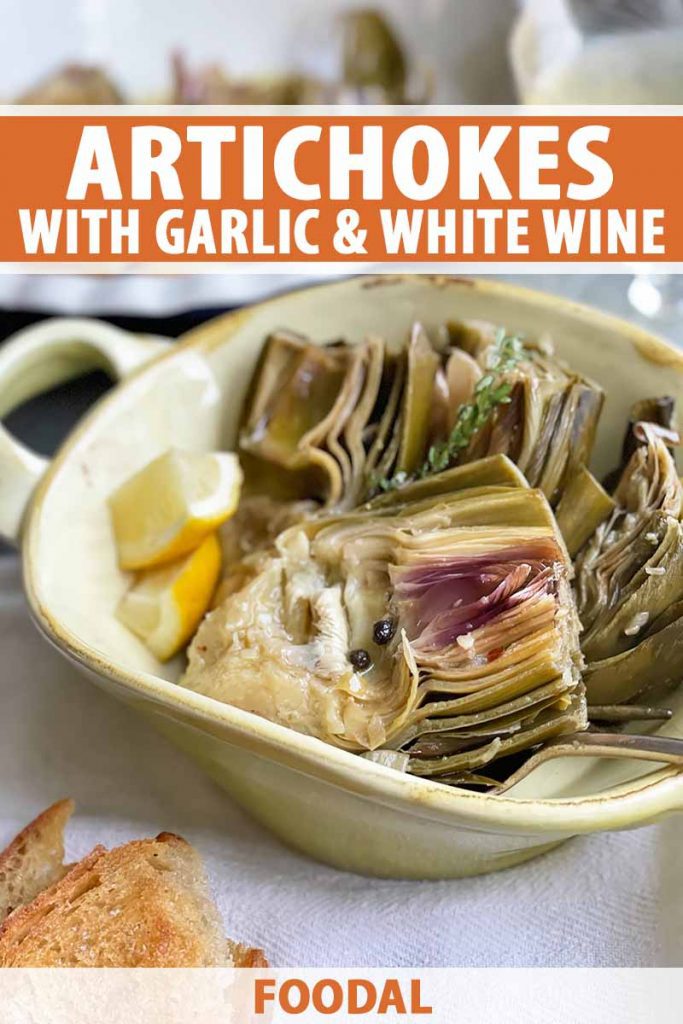If you have an irrational fear of artichokes, you’re not alone.
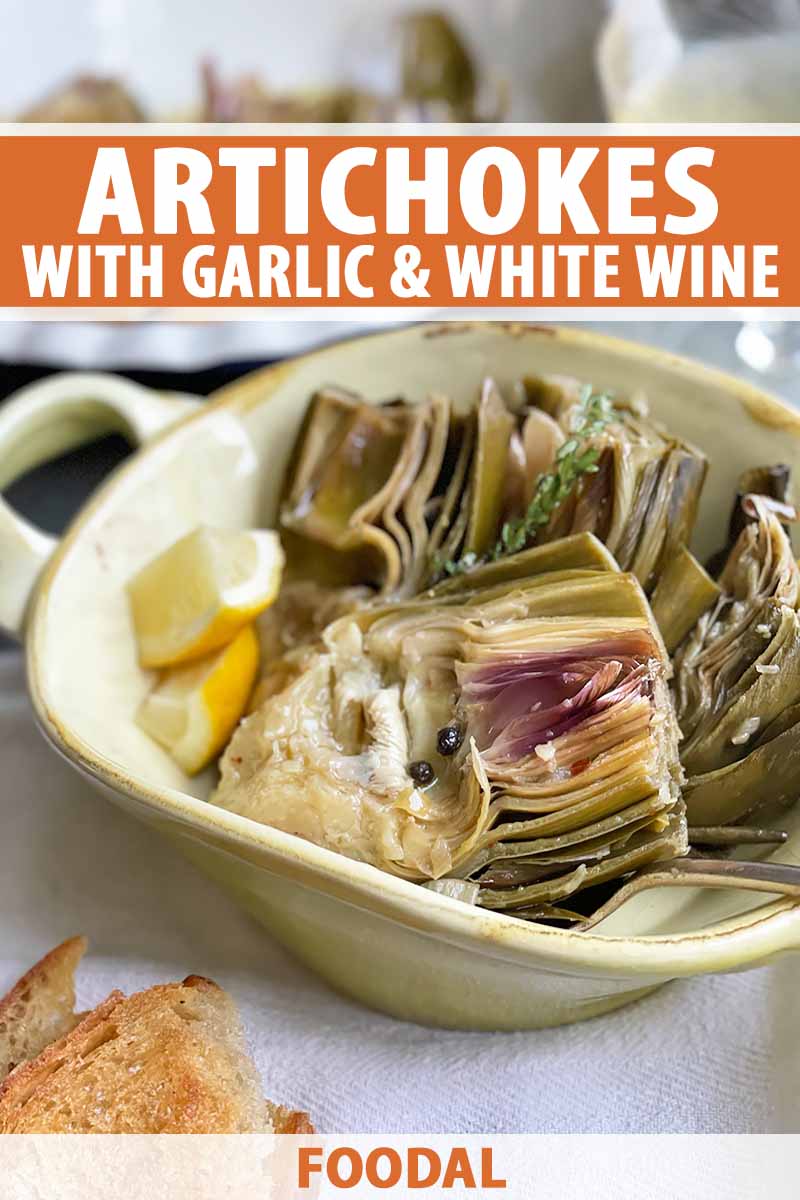
From the pointy leaves to the thick, fuzzy core, it makes sense that even the most skilled cooks and chefs do a double-take when they first approach this daunting veggie.
But once you’ve mastered the prep work, which is surprisingly easy, I promise your anxiety will quickly disappear.
Then you’ll attempt – and totally rock – this recipe and wonder why you haven’t been playing with these veggies all along.
Although they are springtime vegetables, freshest when sourced locally from March through May, I’ve always been able to find them in the produce section of my grocery store, even in the off-season.
Artichokes have always been a part of my family’s food repertoire. I have countless memories of my dad steaming a few in a little lemon water, hollowing out the centers, and stuffing them with his famous secret sauce.
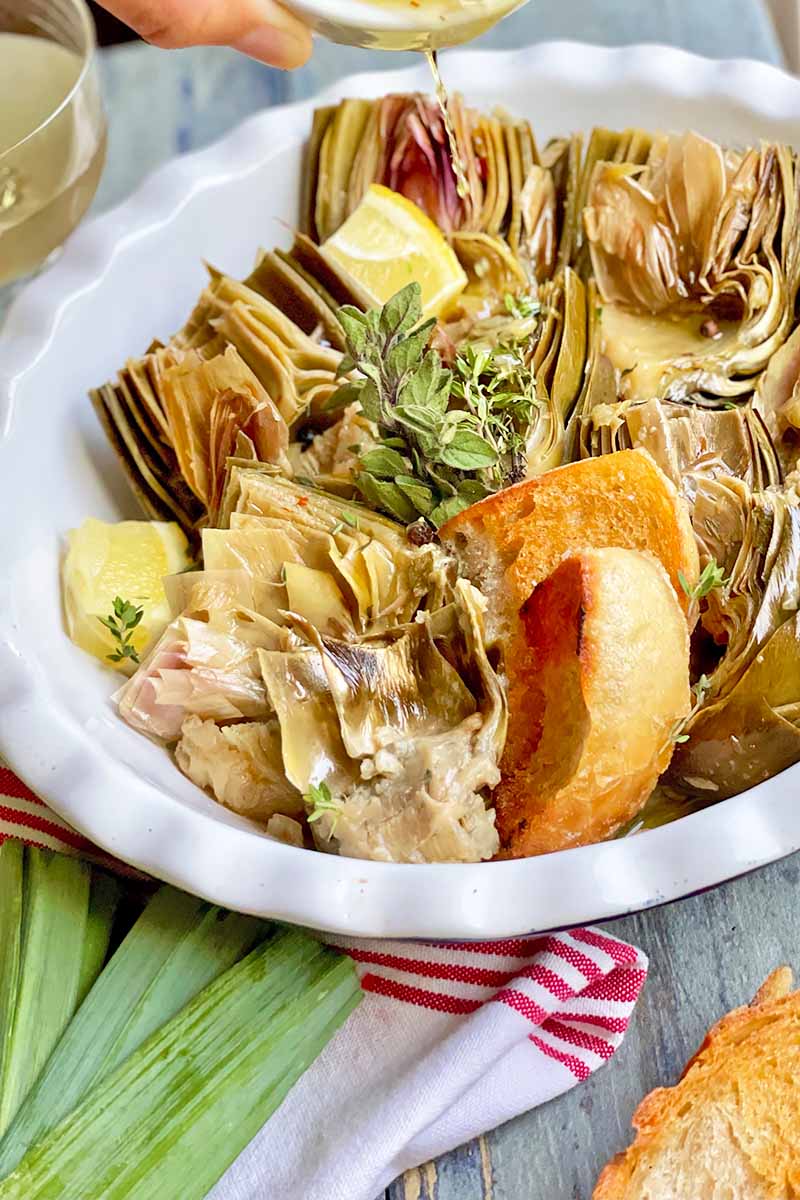
Okay, it was mostly mayonnaise and Dijon mustard, but the smoked paprika and Worcestershire that he added to the mix were straight-up flavor bombs. My mom, dad, sister, and I would gather around the green globes and dunk to our hearts’ delight.
These appetizers kicked off many a meal in our cozy home, so it’s no surprise that artichokes are meaningful to me. But when I started cooking them on my own, I began tinkering with the technique.
I would typically start the recipe with a steam bath (for the artichokes, not me), and enhance the aroma a touch with whole heads of garlic and splashes of dry sherry. When the veggies were halfway cooked, I would toss them on a cutting board, slice them in half, and finish the dish on the grill or in a cast iron pan.
The smokiness brought the flavor to another level, and the hint of char on the leaves added some texture. I never strayed from my dad’s classic dip – but all of this did get the wheels in my head spinning towards other possibilities.
I had stumbled upon a few slow-cooker recipes for artichokes before, but wanted to make the preparation my own. This recipe offers something different.
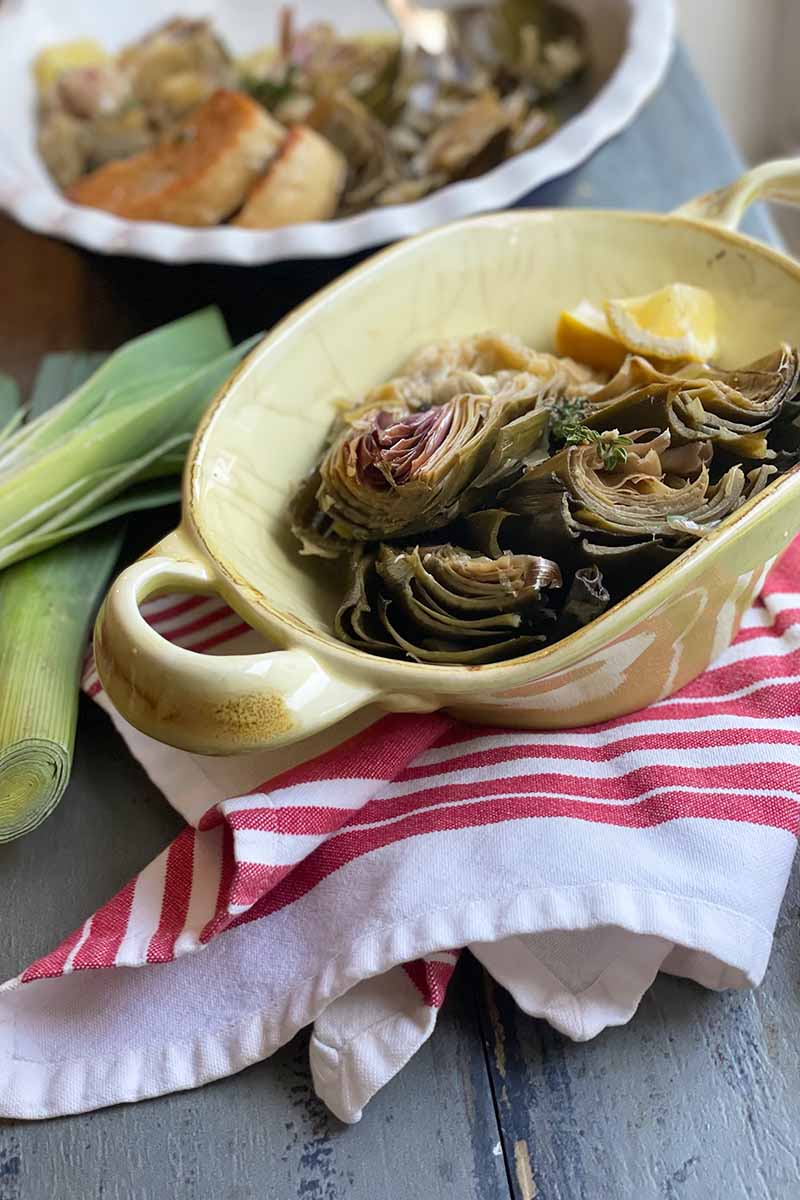
The combination of butter and oil is one of my all-time favorite duos of fats for cooking, so for this version, I went with a hefty pour of both fruity olive oil and tasteless vegetable oil to build the base.
The subtlety of the vegetable oil balances out the pungent olive oil, which can sometimes be overpowering in terms of flavor, while the butter adds richness and depth.
In went dry white wine, fresh thyme and oregano, garlic, leeks, and spices.
I suspected that the leeks would practically dissolve into the buttery abyss and become pure allium perfection when scooped onto crusty bread along with the leftover juices… and I was right.

The citrusy thyme complemented the bright lemon – artichokes and lemons are BFFs, in case you didn’t know. A slight tinge of heat from the red pepper flakes and peppercorns rounded out the dish.
I can’t even begin to describe my excitement when I took the lid off my slow cooker and peeked inside to inspect and have a taste of what had been making my house smell so good for hours.
Not only were the verdant petals tender and fully infused with savory lemon, garlic, and wine, but the hearts literally melted in my mouth.
Good crusty bread (particularly a variety with nooks and crannies that can hold as much of the garlicky liquid as possible) was not just a sidecar, but a necessity to one’s enjoyment of the dish.
Choose your carb vehicles wisely.
Print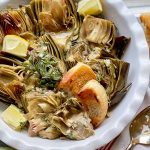
Artichokes Slow-Cooked in Garlic and White Wine
- Total Time: 5 hours, 30 minutes
- Yield: 4-6 servings 1x
Description
Slowly bathed in butter, white wine, garlic, and oil, these savory artichokes are a melt-in-your-mouth appetizer you’ll never forget.
Ingredients
- 2 3/4 cups dry white wine
- 1 cup vegetable oil
- 1 cup extra-virgin olive oil
- 1/2 stick unsalted butter (1/4 cup)
- 4 large lemons
- 1 tablespoon kosher salt, plus more to taste
- 1 teaspoon whole black peppercorns
- 1/8 teaspoon crushed red pepper flakes
- 1 head garlic, peeled (about 6–8 cloves)
- 2 leeks, white and light green parts only, thinly sliced
- 6 sprigs fresh thyme, plus 1 teaspoon chopped for garnish
- 4 sprigs fresh oregano
- 4 large or 6 medium artichokes
- Crusty bread, for serving
Instructions
- Squeeze about 1/2 cup of juice from 3 of the lemons, and reserve the juiced lemons.
- Add the white wine, vegetable oil, olive oil, butter, lemon juice, salt, peppercorns, red pepper flakes, garlic, leeks, thyme sprigs, and oregano to a 6-quart slow cooker.
- Trim off and discard the top third of each artichoke, rubbing each cut as you go with the juiced lemons to prevent browning. Using kitchen shears, snip off the top portion of any remaining outer leaves to remove the thorny tips. Pull away or trim off any discolored leaves.
- Using a vegetable peeler, peel away the tough outer layer of the stems, and then cut each artichoke in half vertically through the stem. Discard the furry choke and small thorny leaves, cut lengthwise again so you have quarters, and immediately place each finished quarter into the liquid in the slow cooker, making sure to submerge them as much as possible.
- Cook on high for 4-5 hours, or until the leaves easily pull away and the hearts are very tender. Season to taste with additional salt if necessary. Cut the remaining lemon into wedges for serving.
- Transfer the artichokes, leeks, and garlic to a serving platter, and drizzle some of the cooking liquid over the top. Serve slightly warm or at room temperature. Garnish with the reserved chopped thyme, lemon wedges, and crusty bread.
Notes
Please note that the nutritional info below is an estimate that includes all of the cooking liquid. Dipping is encouraged, but these calorie counts are skewed! It’s very unlikely that you will actually consume all of the butter and oil used in cooking this recipe.
- Prep Time: 30 minutes
- Cook Time: 5 hours
- Category: Appetizers
- Method: Slow-Cooker
- Cuisine: Vegetarian
Keywords: artichoke, garlic, leek, lemon
Cooking By the Numbers…
Step 1 – Prepare the Cooking Liquid for the Slow Cooker
Squeeze about 1/2 cup of juice from 3 of the lemons. Reserve the juiced lemons. Slice the remaining lemon into wedges for the serving platter.

Peel the garlic. Slice and rinse the leeks in a colander under running water to remove any dirt that’s trapped between the layers.
Select large oregano and thyme sprigs from the garden or bunches of herbs that you’ve purchased. To grow your own, you can find guides to growing herbs at home on our sister site, Gardener’s Path!
Chop 1 teaspoon of the thyme for garnish.
Add the white wine (open a bottle of a dry variety such as Sauvignon Blanc or a crisp Pinot Grigio), vegetable oil, olive oil, butter, lemon juice, salt, peppercorns, red pepper flakes, garlic, leeks, thyme sprigs, and oregano to a 6-quart slow cooker.
Step 2 – Prep the Artichokes
If you aren’t already well-versed in the topic, read our full guide to mastering artichoke prep.
Using a serrated knife or a sharp chef’s knife to make sure you slice through the tough leaves evenly, trim off and discard the top third of each artichoke. Rub each cut with one of the juiced lemon halves as you go, to prevent browning.
Using kitchen shears, cut off the top portion of any remaining outer leaves to remove the thorny tips. Pull away or trim off any discolored leaves.
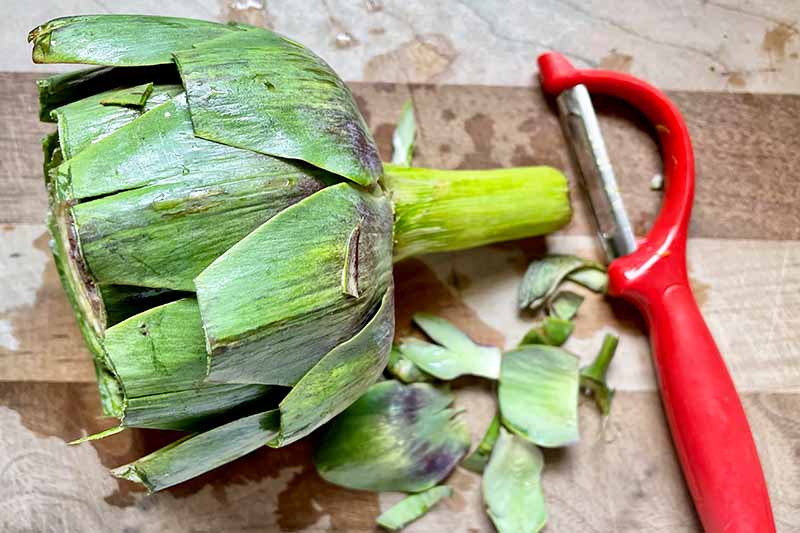
Using a vegetable peeler, peel away the tough outer layer of the stems.
Cut the artichokes in half lengthwise from tip to stem. With a small spoon, scoop out and discard the hairy choke and thorny inner leaves. Cut in half lengthwise again so each is quartered.
Immediately place each finished quarter into the liquid in the slow cooker, making sure to submerge them as much as possible.
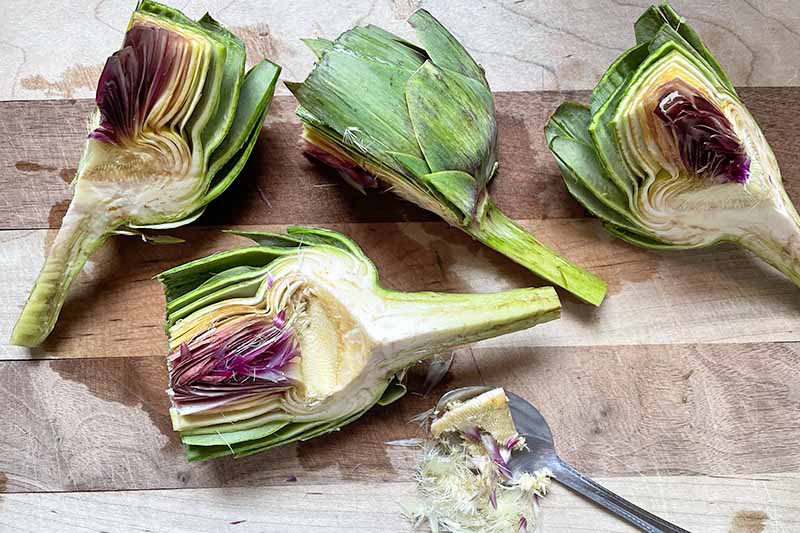
You can also place the finished quarters into a bowl of cold lemon water while you’re prepping the rest, if you prefer. You’ll want to use about 1/2 cup lemon juice mixed with enough water to cover the quarters.
Artichokes are especially prone to oxidation (browning) once they’ve been sliced, which is why both rubbing their cut surfaces with lemon juice and submerging them in acidic water is preferable, to avoid discoloration.
Step 3 – Cook
Cook on high for 4 to 5 hours, or until the leaves easily pull away and the hearts are very tender.
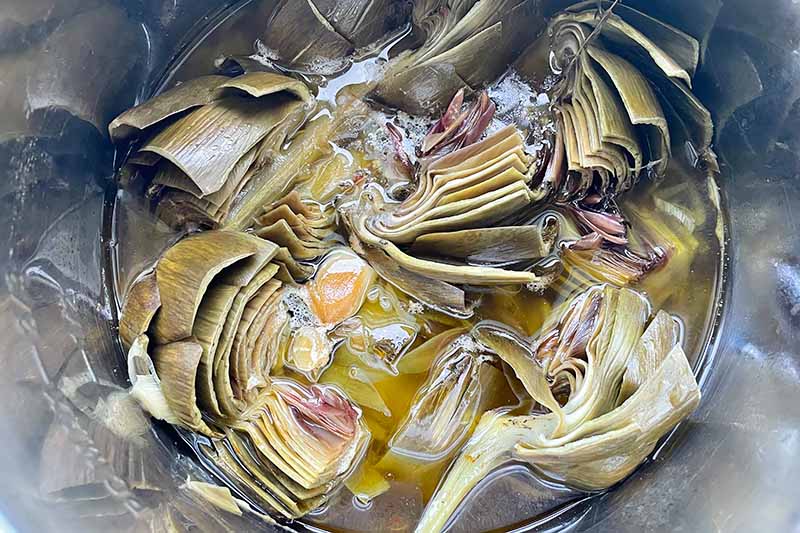
If you’re using your Instant Pot as a slow cooker, you can use the following time conversions:
Either cook (with the lid sealed) in slow cook mode on the “More” setting for 4 to 5 hours, or cook on the “Normal” setting and add 15 minutes to each hour of cooking time. Using the latter method, the artichokes will be done in somewhere between 5 hours to 5 hours and 15 minutes.
Season to taste with additional salt before serving if necessary.
Step 4 – Serve
A crusty baguette or focaccia makes a great vehicle for sopping up the sauce, so if you’re serving this tasty app with bread, now would be the time to warm or toast it.
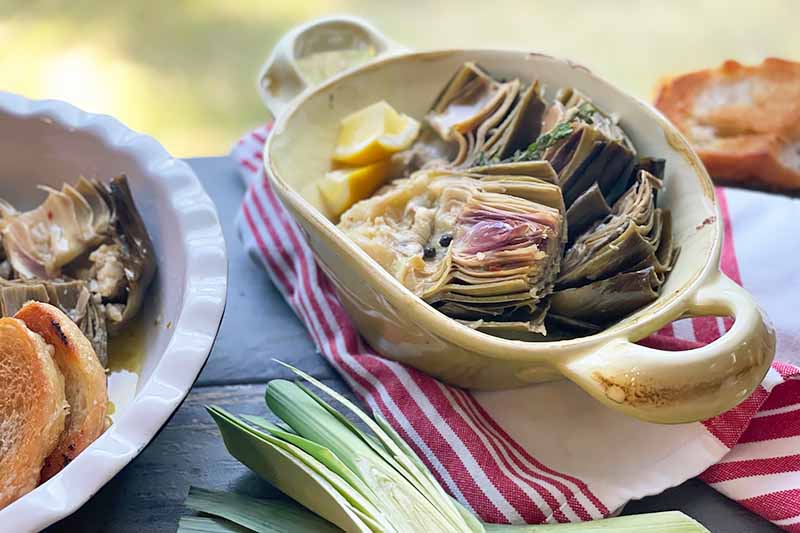
The artichokes may be served slightly warm or at room temperature. Transfer them along with the leeks and garlic to a serving platter. Strain the liquid to remove the peppercorns and herbs, and discard them. Drizzle some over the top of the artichokes.
Serve the rest alongside the veggies for dipping, and use any remaining liquid as a pasta sauce, pizza base, or marinating liquid for any leftover artichoke hearts. You can also use it as a finishing oil to drizzle over fish or chicken. Just be sure to strain out the peppercorns.
Garnish with the reserved chopped thyme, lemon wedges, and crusty bread.
The Art of Artichokes
Ladled over a pile of tennis shoes, the rich cooking juices in this dish would still be satisfying AF. But you’ll probably want to stick with the artichokes.
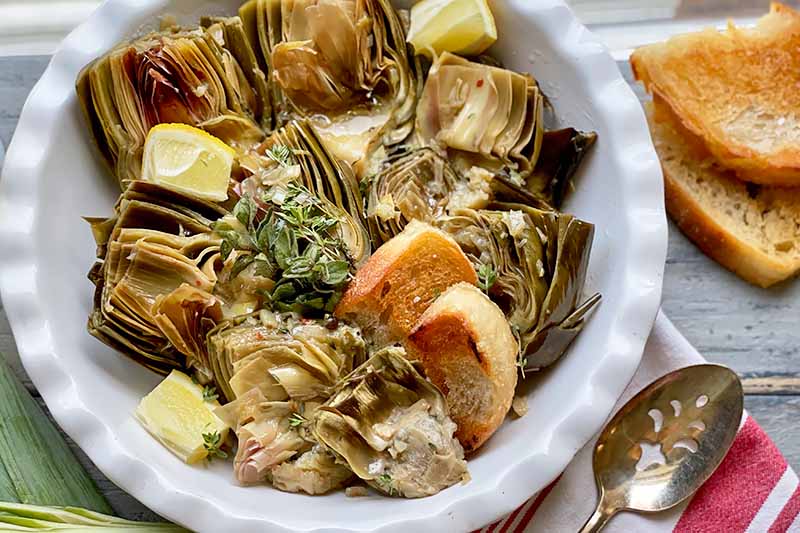
And when you just can’t take one more bite? Take a tip from my book for an impressive repurposing:
Pluck off the remaining artichoke hearts and place them in a container in the fridge with any leftover leeks, and enough of the strained cooking liquid to cover them.
The following day, pull out your finest pizza dough and use the veggies as a topping along with some ricotta, grated or shaved parmesan, more red pepper flakes, and a handful of spinach.
Bake according to the dough instructions or until the crust has risen and is golden brown, and the cheese is melted and bubbly. Drizzle the finished pie with the flavorful liquid, and stand back and say ta-da! as loudly as possible.
Still a little uneasy about working with or eating artichokes? Keep getting your feet wet with the following recipes:
I had fresh thyme and oregano on hand when I made this, but the final call can be all yours.
Basil? Tarragon? What fresh flavor will you reach for? Share your herby ideas in the comments below! And don’t forget to give this recipe a five-star rating if you loved it.
Photos by Fanny Slater, © Ask the Experts, LLC. ALL RIGHTS RESERVED. See our TOS for more details. Originally published on October 21, 2013. Last updated on September 11, 2021.
About Fanny Slater
Fanny Slater is a home-taught food enthusiast based in Wilmington, North Carolina who won the “Rachael Ray Show” Great American Cookbook Competition in 2014, and published her cookbook “Orange, Lavender & Figs” in 2016. Fanny is a food and beverage writer, recipe developer, and social media influencer. She was a co-host on the Food Network series “Kitchen Sink,” was featured on Cooking Channel’s longtime popular series “The Best Thing I Ever Ate,” and continues to appear regularly on the “Rachael Ray Show.”

